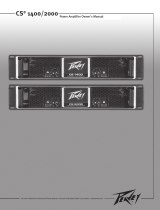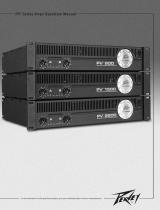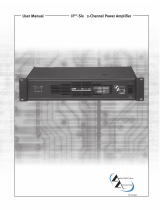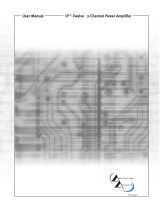Page is loading ...

Messenger
™
M100
Portable PA System
For more information on other great Peavey products, visit your local Peavey dealer or visit us online at www.peavey.com

3
IMPORTANT SAFETY INSTRUCTIONS
WARNING: When using electrical products, basic cautions should always be followed, including the following:
1. Read these instructions.
2. Keep these instructions.
3. Heed all warnings.
4. Follow all instructions.
5. Do not use this apparatus near water.
6. Clean only with a dry cloth.
7. Do not block any of the ventilation openings. Install in accordance with manufacturer’s instructions.
8. Do not install near any heat sources such as radiators, heat registers, stoves or other apparatus (including amplifiers)
that produce heat.
9. Do not defeat the safety purpose of the polarized or grounding-type plug. A polarized plug has two blades with one
wider than the other. A grounding type plug has two blades and a third grounding plug. The wide blade or third prong is
provided for your safety. If the provided plug does not fit into your outlet, consult an electrician for replacement of the
obsolete outlet.
10. Protect the power cord from being walked on or pinched, particularly at plugs, convenience receptacles, and the point
they exit from the apparatus.
11. Only use attachments/accessories provided by the manufacturer.
12. Use only with a cart, stand, tripod, bracket, or table specified by the manufacturer, or sold with the apparatus. When a
cart is used, use caution when moving the cart/apparatus combination to avoid injury from tip-over.
13. Unplug this apparatus during lightning storms or when unused for long periods of time.
14. Refer all servicing to qualified service personnel. Servicing is required when the apparatus has been damaged in any
way, such as power-supply cord or plug is damaged, liquid has been spilled or objects have fallen into the apparatus,
the apparatus has been exposed to rain or moisture, does not operate normally, or has been dropped.
15. Never break off the ground pin. Write for our free booklet “Shock Hazard and Grounding.” Connect only to a power
supply of the type marked on the unit adjacent to the power supply cord.
16. If this product is to be mounted in an equipment rack, rear support should be provided.
17. Note for UK only: If the colors of the wires in the mains lead of this unit do not correspond with the terminals in your
plug‚ proceed as follows:
a) The wire that is colored green and yellow must be connected to the terminal that is marked by the letter E‚ the earth
symbol‚ colored green or colored green and yellow.
b) The wire that is colored blue must be connected to the terminal that is marked with the letter N or the color black.
c) The wire that is colored brown must be connected to the terminal that is marked with the letter L or the color red.
18. This electrical apparatus should not be exposed to dripping or splashing and care should be taken not to place objects
containing liquids, such as vases, upon the apparatus.
19. Exposure to extremely high noise levels may cause a permanent hearing loss. Individuals vary considerably in suscep
-
tibility to noise-induced hearing loss, but nearly everyone will lose some hearing if exposed to sufficiently intense noise
for a sufficient time. The U.S. Government’s Occupational Safety and Health Administration (OSHA) has specified the
following permissible noise level exposures:
Duration Per Day In Hours Sound Level dBA, Slow Response
8 90
6 92
4 95
3 97
2 100
1 1⁄2 102
1 105
1⁄2 110
1⁄4 or less 115
According to OSHA, any exposure in excess of the above permissible limits could result in some hearing loss. Ear plugs or protectors to
the ear canals or over the ears must be worn when operating this amplification system in order to prevent a permanent hearing loss, if
exposure is in excess of the limits as set forth above. To ensure against potentially dangerous exposure to high sound pressure levels, it is
recommended that all persons exposed to equipment capable of producing high sound pressure levels such as this amplification system be
protected by hearing protectors while this unit is in operation.
SAVE THESE INSTRUCTIONS!

Peavey Messenger™ M100
Thank you for purchasing this complete, portable PA system. The Messenger is compact enough to fit in the overhead storage
compartment of an airplane, yet is functional and powerful enough to be used as a professional sound system for small venues. The
Messenger features a 100 watt, two-channel amplifier, a five-channel mixer and two removable, two-way high output speakers
incorporating dual 4" woofers and a 1" tweeter each. Molded from a high-impact polypropylene polymer, the Messenger offers the
only complete PA system in a protective briefcase with a spare compartment for microphone and cable storage.
The Messenger has several innovative, specialized features that make it very useful for many types of events. Among these is Split
Track Mix, a feature specifically designed to control a split audio track’s voice and music volumes independently so you can adjust
the vocals-to-music ratio differently for rehearsals and live performances. This combo channel (ch 4/5) is versatile enough to
accommodate normal stereo inputs, as well, or can be used in mono for five total mixer inputs.
These features help make the Messenger the ideal sound system for:
Weddings
Business Presentations
Choir and Music Rehearsal
Pageant
Dance
School functions
and so many more...
Your Messenger includes all the accessories needed to get started:
Mixer
Speakers
Microphone
Cables
Lectern
Table of Contents
Page
Features . . . . . . . . . . . . . . . . . . . . . . . . . . . . . . . . . 8
Quick Setup Guide . . . . . . . . . . . . . . . . . . . . . . . . .
9
Setting Up Mixer and Speakers . . . . . . . .
9
Connecting Microphone(s) . . . . . . . . . . . .
10
Connecting CD, Tape
or Other Line Sources . . . . . . . . . . . . .
10
Split Track Mix
. . . . . . . . . . . . . . . . . . . . . 10
Connecting Power . . . . . . . . . . . . . . . . . . .
11
Setting Controls and Turning Unit On
. . . . . . . . . 11
Adjusting Gain and Volume Controls (Faders) . . .
11
Adjusting Tone Controls . . . . . . . . . . . . . . . . . . . . .
11
Using the Graphic Equalizer
. . . . . . . . . . . . . . . . . 11
Avoiding Acoustic Feedback
. . . . . . . . . . . . . . . . . 12
Microphone Usage Guidelines . . . . . . . . . . . . . . . .
12
Auxiliary Output (LINE OUT) Operation
. . . . . . 12
Optional Accessories
. . . . . . . . . . . . . . . . . . . . . . . 12
Troubleshooting Guide . . . . . . . . . . . . . . . . . . . . . .
13
Specifications . . . . . . . . . . . . . . . . . . . . . . . . . . . . . 14
7
ENGLISH

Messenger™ M100 FEATURES
• Molded, high-impact polypropylene carrying case
Convenient briefcase design
Modern ergonomics
Light weight
Interlock speakers
Internal space for cable and microphone storage
• Powered Mixer
100 watts continuous power
Two master speaker channels with independent volume control
Five channels of input with independent volume, low-mid and high EQ controls, including Mid Morph
™EQ
on channels 1 and 2
Five band graphic EQ featuring FLS
® (
Feedback Locating System)
Channels 4 and 5 feature Split Track mix with track-swap switch
Two XLR microphone input with phantom power
One high gain instrument/microphone input
Three line-level inputs
Two RCA/phono inputs
Two RCA/phono outputs
Headphone output
Headphone level control
1
1
/
4
" phone line out
• Two high-efficiency, two-way speakers
Molded polypropylene enclosures
Metal grille
Two 4" high output woofers per speaker
1 x 1" tweeter
Molded speaker stand receptacle
• PV
®
i 100 handheld microphone
Dynamic cardioid
Metal grille
On/Off switch
XLR balanced output
• Cables
Two 12' speaker cables
One 15' XLR balanced microphone cable
One line cord
8

Quick Setup Guide
THINK SAFETY FIRST!
Much of the setup of the Messenger
™
M100 is similar to the setup of other sound systems, and many aspects require plain
common sense. Safety should always be your first concern. Always use grounded outlets and three-wire extension cords.
Run sound system cables in a way to prevent the danger of tripping, and tape them down where necessary. Place the
speaker stands and mixer stand on a solid, level surface. Following these guidelines will help prevent personal injury and
equipment damage
.
Setting Up Mixer and Speakers
Place the unit on a horizontal surface. Release the latches by lifting up until they disengage. Open the top cover and remove
the speakers from the Messenger package.
Place speakers on a suitable surface and position them so that they will face toward the audience and away from the
microphones. All of the necessary interconnect cables can be found in the convenient zipper pouch. Connect the speaker
cables from the jack on the rear of each speaker to the powered mixer, connecting the left speaker to the LEFT OUTPUT
and the right speaker to the RIGHT OUTPUT jacks on the side panel of the unit.
Warning! Do not connect additional speakers to the Messenger powered mixer. The included speakers
provide the optimal load for the amplifier.
9

10
Connecting Microphone(s)
The Messenger™ M100 powered mixer is designed to work with any good-quality,
balanced, dynamic or condenser microphone such as the supplied PV
®
i model. Connect
the microphone(s) to the XLR (three-pin) input connectors as shown. When using more
than one mic, try to connect them to channels in the same order as they appear on stage
to make them easier to identify and control.
Split Track Mix
Split Track is a featured used on many sing along CDs and cassettes. The vocals are on one
side (track) while the music is on the other track. The advantage is that the music can be
played without or with only a small amount of vocals during the performance (to help
stay on key and beat/que). The Messenger has provisions for the split track feature built
in. Channels 4 and 5 have independent volume controls that are controlled by a master
channel volume.
For example:
If you want to increase the volume of the pre-recorded material (both tracks) to the
level of the other channels (such as a live singer), simply increase the channel 4/5
master volume.
If you want to increase the volume of the music over the vocals, simply increase the
music control on ch 4/5 or vice versa for vocals.
This method is much better than a balance or fader because it allows one track to be controlled independently
of the other, whereas faders and balance controls reduce one channel while increasing the other.
Since the recording companies who produce these split-track cassettes often use differing production methods,
sometimes the music and vocal tracks are swapped—meaning that the Music and Voice controls on channel 4/5
will be respectively backward. What you would expect to hear when adjusting the Music level control would be
the voice, and vice versa.
We’ve included a “swap” button on this channel that allows you to flip-flop the tracks so our Music and Voice
level controls always adjust the correct track. If you adjust the Messenger’s Music control and notice a change
in the vocal volume, for example, then simply press the Music Track Select button. The Music control will then
adjust the music, and the Voice control will adjust the vocals.
Connecting CD, Tape or Other Line Sources
Simply connect the output of the device to the channel 4/5 RCA/phono inputs. Red is right
and white is left. For normal audio play, be sure to set the vocal and music volume controls
on channel 4/5 to “5.” The channel master volume is used to control the volume of the
track.
LOW
HIGH
LOW
MID
MUSIC
CHANNEL MASTER
VOICE
4/5
REVERSE
NORMAL
MUSIC TRACK SELECT
0
1
2
3
4
5
6
7
8
9
10
0
1
2
3
4
5
6
7
8
9
10
0
1
2
3
4
5
6
7
8
9
10
-15 +15
-15 +15
-15 +15

11
the color red.
Setting Controls and Turning Unit On (1)
Set MASTER LEVEL controls to the “5” position and all other controls to “0” (all graphic EQ sliders should be
on “0”). Turn on power by placing the OFF/ON switch, located adjacent to the IEC cord receptacle, in the ON
position.
Adjusting Gain and Volume Controls (Faders) (2)
With the master level at “5,” adjust the channel LEVEL controls for desired volume from the speakers. If the
desired volume is reached with the channel LEVEL at a low setting (1-3), lower the MASTER LEVEL controls. If
the channel LEVEL needs to be set at 9-10 for desired volume, raise the MASTER LEVEL controls. The L and R
MASTER LEVEL controls adjust the left and right speakers.
Adjusting Tone Controls (3)
Adjust the channel LOW, MID and HIGH controls as necessary to achieve the desired sound. However,
use moderation in setting channel tone controls. The Mid EQ is a unique tone control designed to provide
a wide variation of mid-range frequencies. Turning the knob to the left (counterclockwise) adds warmth
and smoothness to the voice, while rotating the control to the right (clockwise) enhances vocal intelligibility.
Extreme settings of these controls can adversely affect sound quality. Large amounts of boost (+) on these
controls can also increase the chance of feedback on microphone inputs.
Using the Graphic Equalizer (4)
Unlike the LOW and HIGH controls on each channel, the five-band graphic equalizer adjusts the tonal balance
of all the signals going through the powered mixer. This gives the user greater flexibility in adjusting the sound,
OUTPUT S
9
8
7
6
5
4
3
2
1
0
10
HIGH
LOW
MID MORPH
HIGH
LOW
HIGH
LOW
MID
HIGH
LOW
MID
MUSIC
CHANNEL MASTER
VOICE
1
INPUTS
2 3 4/5
LEVEL LEVEL LEVEL
LEVEL
LEFT RIGHT
MASTER LEVEL
+12+12
+6+6
00
-6
-6
-12-12
LOW LOW
MID
MID HIGH
MID
HIGH
5 BAND EQUALIZER
FLS
®
FEEDBACK LOCATING SYSTEM
U.S. PATENT # 5,737,428
POWER
+HI
-LO
MID MORPH
+HI
-LO
REVERSE
NORMAL
MUSIC TRACK SELECT
0
1
2
3
4
5
6
7
8
9
10
0
1
2
3
4
5
6
7
8
9
10
0
1
2
3
4
5
6
7
8
9
10
-15 +15
-15 +15
-15 +15
-15 +15
-15 +15
-15 +15
-15 +15
-15 +15
-15 +15
-15 +15
10
9
88
7
6
5
4
3
2
1
0
10
9
88
7
6
5
4
3
2
1
0
10
9
88
7
6
5
4
3
2
1
0
FLS
1
22
2
3
3 3 3
4
5
1
Connecting Power
Before connecting power, make sure that the power switch is in the OFF position.
Connect the IEC power cord to the receptacle on the back panel of the unit, and then to
a suitable electrical outlet. If an extension cord is used, be sure that it is a three-wire cord
with ground pin intact to preserve the safety ground.
NOTE: FOR U.K. ONLY
If the colors of the wires in the mains lead of this unit do not correspond to the colored markings identifying the
terminals in your plug, proceed as follows: (1) The wire that is colored green and yellow must be connected to
the terminal that is marked by the letter E, the earth symbol; colored green; or colored green and yellow. (2)
The wire that is colored blue must be connected to the terminal that is marked with the letter N or the color
black. (3) The wire that is colored brown must be connected to the terminal that is marked with the letter L or

12
but use moderation in making adjustments.
Avoiding Acoustic Feedback (5)
Acoustic feedback is the loud howl or squealing sound heard through sound systems as the result of sound
from the speakers re-entering the microphones. Although it does an excellent job of getting the audience’s
attention, feedback should be avoided. When dealing with acoustic feedback, it is always best to start looking at
the placement of the mics and speakers in the system before resorting to equalization (EQ) adjustments. Make
sure that the speakers are positioned to direct the sound toward the audience and away from the microphones.
Position mics as close to the sound source as reasonable. Moving the mic closer to the person singing or
speaking increases the volume of the sound through the system without having to turn up the gain.
The FLS
®
(Feedback Locating System) LED indicators (small red lights) are invaluable tools in helping to
reduce/eliminate feedback. To use the FLS feature, start by setting all graphic EQ sliders to “0”. Then, before
the audience arrives, increase the MASTER LEVEL and/or CHANNEL LEVEL until feedback occurs. Note
which LED illuminates and slightly lower its corresponding EQ slider. This reduces the volume at the feedback
frequency and can be repeated if necessary to improve volume before feedback. However, only lower the
sliders in small amounts to avoid adversely affecting sound quality.
Microphone Usage Guidelines
When practical, a single microphone is preferred.
Additional microphones will pick up more sound
from the speakers and each mic must then be
turned down to prevent feedback. However, if
you have difficulty balancing the level of different
individuals using a single mic, or if you still cannot
get sufficient gain, using more mics can offer an advantage. For example, giving several singers their own
microphones allows you to place the microphones much closer to their users. This increases the volume of the
sound at the mic and far outweighs any detrimental effect from using multiple mics. It also allows the volume of
each mic to be adjusted separately for proper balance. Always have the microphone as close to the instrument
or singer's mouth as possible. The singer should hold the microphone directly in front of his/her mouth for best
results and to help avoid a "thin" sound. This is why professionals say "eat the mic."
Auxiliary Output (LINE OUT) Operation
The LINE OUT is a line-level output from the mixer that can be used for recording or
driving an auxiliary amplifier.
Warning: Connecting a tape machine to the LINE OUT to record while simultaneously connecting the
tape machine’s output into the mixer inputs can create an electronic feedback loop. Connect only the
tape machine’s inputs
or outputs to the mixer, never both.
Optional Accessories (available from Peavey dealers)
Microphone stand(s)
Additional microphones and cables
Microphone wind screens (grilles)
Additional speaker cables in various lengths
Additional speaker stands in various heights
Audio cables for CD and cassette

13
Problem Check Correction
No sound
(no power light)
Is power switch on?
Is line cord connected to live power outlet?
Turn power switch on.
Connect power cord to live outlet.
No sound (power light on) Are MASTER and CHANNEL
LEVEL controls
up?
Adjust both MASTER and CHANNEL LEVEL
controls upward to desired level. Check
speaker connections. Turn mic switch on.
Check mic or sound source connection.
System hum Are all line cord ground connections made
properly on Messenger™ and any auxiliary
equipment connected to Messenger?
Are all connections secure?
Are all interconnect cables shielded, except
the speaker cables?
Does the system hum when touching
microphone?
Turn the volume down on each channel
starting with channel 1, working through the
mixer channels to determine if the problem
is coming from an external audio source,
such as a malfunction in that source or a bad
recording.
We recommend that all units connected to
the Messenger be plugged into the same AC
power strip.
Change the microphone cable and/or
microphone.
Only one speaker works Are speaker cable connectors secure?
Are both MASTER LEVEL controls up?
Fully insert connector and/or swap speaker
cables between left and right speakers and
outputs to check for damaged cables.
Loud howling or squeal from speakers
(known as "feedback" by audio professionals)
If it goes away when the CHANNEL or
MASTER volume controls are lowered, it is
acoustic feedback.
Refer to Avoiding Acoustic Feedback and
Using Graphic EQ sections of this manual.
Reduce microphone volume. Reposition
microphone behind or farther from speakers.
Observe FLS light above EQ and reduce level
of that band.
Sound is distorted Is the CHANNEL LEVEL at a very high
setting?
Reduce CHANNEL LEVEL and increase
MASTER LEVEL.
Troubleshooting Guide

14
Messenger™ M100 Specifications
Output Power: 50 watts per channel into 4 ohm load
Frequency Response: 40 Hz to 25 kHz +0/-3 dB measured at 1 W
Distortion: Less than 0.8% THD at rated output
Signal/Noise Ratio: 85 dB mic input typical
AC Power: 115 VAC 60 Hz or
230 VAC 50/60 Hz
Weight: Assembled: 19.5 lbs. (8.8 kg)
Dimensions: 13.5" H x 24.5" W x 5.25" D
(34.3 cm H x 62.2 cm W x 13.3 cm D)
Speakers: Woofer 4" (100 mm)
Dynamic 1" (25 mm) Horn Tweeter
Microphone: Dynamic, Cardioid (Unidirectional)

30
Messenger™ M100 Spécifications
Puissance de sortie: 50 watts par canal sous 4 ohm
Réponse en fréquence: 40 Hz à 25 kHz +0/-3 dB mesure a 1 W
Distortion: moins de 0.8% THD
Ratio signal/bruit: 85dB signal micro standard
Puissance AC: 115 VAC 60 Hz ou 230 VAC 50/60 Hz
Poids Assemblé:
8.8kg
Dimensions: (34.3 cm H x 62.2 cm L x 13.3 cm P)
Enceintes: 2 haut-parleurs de 4” (100 mm)
tweeter de 1” (25 mm)
Microphone: cardioïde unidirectionnel

39
PEAVEY ELECTRONICS CORPORATION LIMITED WARRANTY
Effective Date: July 1, 1998
What This Warranty Covers
Your Peavey Warranty covers defects in material and workmanship in Peavey products purchased and serviced in the U.S.A. and Canada.
What This Warranty Does Not Cover
The Warranty does not cover: (1) damage caused by accident, misuse, abuse, improper installation or operation, rental, product modification or neglect; (2) dam
-
age occurring during shipment; (3) damage caused by repair or service performed by persons not authorized by Peavey; (4) products on which the serial number
has been altered, defaced or removed; (5) products not purchased from an Authorized Peavey Dealer.
Who This Warranty Protects
This Warranty protects only the original retail purchaser of the product.
How Long This Warranty Lasts
The Warranty begins on the date of purchase by the original retail purchaser. The duration of the Warranty is as follows:
Product Category Duration
Guitars/Basses, Amplifiers, Pre-Amplifiers, Mixers, Electronic
Crossovers and Equalizers 2 years *(+ 3 years)
Drums 2 years *(+ 1 year)
Enclosures 3 years *(+ 2 years)
Digital Effect Devices and Keyboard and MIDI Controllers 1 year *(+ 1 year)
Microphones 2 years
Speaker Components (incl. speakers, baskets, drivers,
diaphragm replacement kits and passive crossovers)
and all Accessories 1 year
Tubes and Meters 90 days
[*Denotes additional warranty period applicable if optional Warranty Registration Card is completed and returned to Peavey by original retail purchaser within 90 days of purchase.]
What Peavey Will Do
We will repair or replace (at Peavey's discretion) products covered by warranty at no charge for labor or materials. If the product or component must be shipped
to Peavey for warranty service, the consumer must pay initial shipping charges. If the repairs are covered by warranty, Peavey will pay the return shipping
charges.
How To Get Warranty Service
(1) Take the defective item and your sales receipt or other proof of date of purchase to your Authorized Peavey Dealer or Authorized Peavey Service Center.
OR
(2) Ship the defective item, prepaid, to Peavey Electronics Corporation, International Service Center, 412 Highway 11 & 80 East, Meridian, MS 39301 or Peavey
Canada Ltd., 95 Shields Court, Markham, Ontario, Canada L3R 9T5. Include a detailed description of the problem, together with a copy of your sales receipt or
other proof of date of purchase as evidence of warranty coverage. Also provide a complete return address.
Limitation of Implied Warranties
ANY IMPLIED WARRANTIES, INCLUDING WARRANTIES OF MERCHANTABILITY AND FITNESS FOR A PARTICULAR PURPOSE, ARE LIMITED IN DURATION TO THE
LENGTH OF THIS WARRANTY.
Some states do not allow limitations on how long an implied warranty lasts, so the above limitation may not apply to you.
Exclusions of Damages
PEAVEY'S LIABILITY FOR ANY DEFECTIVE PRODUCT IS LIMITED TO THE REPAIR OR REPLACEMENT OF THE PRODUCT, AT PEAVEY'S OPTION. IF WE ELECT TO
REPLACE THE PRODUCT, THE REPLACEMENT MAY BE A RECONDITIONED UNIT. PEAVEY SHALL NOT BE LIABLE FOR DAMAGES BASED ON INCONVENIENCE,
LOSS OF USE, LOST PROFITS, LOST SAVINGS, DAMAGE TO ANY OTHER EQUIPMENT OR OTHER ITEMS AT THE SITE OF USE, OR ANY OTHER DAMAGES WHETHER
INCIDENTAL, CONSEQUENTIAL OR OTHERWISE, EVEN IF PEAVEY HAS BEEN ADVISED OF THE POSSIBILITY OF SUCH DAMAGES.
Some states do not allow the exclusion or limitation of incidental or consequential damages, so the above limitation or exclusion may not apply to you.
This Warranty gives you specific legal rights, and you may also have other rights which vary from state to state.
If you have any questions about this warranty or service received or if you need assistance in locating an Authorized Service Center, please contact the Peavey
International Service Center at (601) 483-5365 / Peavey Canada Ltd. at (905) 475-2578.
Features and specifications subject to change without notice.

Features and specifications subject to change without notice.
Peavey Electronics Corporation • 711 A Street • Meridian • MS • 39301
(601) 483-5365 • FAX (601) 486-1278 • www.peavey.com
EX000013
©2005
/






